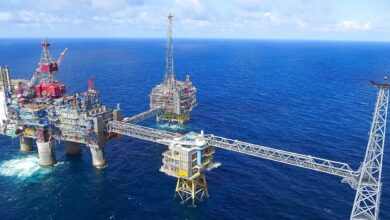GustoMSC’s “Bully” series newbuild drillship designs integrating surface BOP and subsea BOP operations will come to fruition in mid-2010.
Laurens Claassen, engineer of drilling technology for GustoMSC, spoke about the company’s plans and achievements with this project in his paper, “Newbuild Compact Deepwater Drillship Designed for Surface BOP System,” at the 2010 Offshore Technology Conference on 6 May.
GustoMSC’s goal in designing and building drillships of this magnitude, according Mr Claassen, is to “provide lower rates for deepwater with surface BOP technology.” The ships focus on “function and fit-for-purpose design that can maintain flexibility in changing situations,” he said.

In 2003, GustoMSC was contacted by Frontier Drilling to customize the Bully drillships. In 2007, Shell and Frontier signed a deepwater/arctic drillship agreement to construct their newbuild drillship concept.
“This is freedom for the client to have this kind of alternative drillship,” he said. “We’re not limited to a particular company. We are independent,” Mr Claassen said.
These drillships provide “a competitive solution for the deepwater campaign, which conventionally would require a sixth-generation drillship,” he continued.
The design philosophy of the Bully I and Bully II focuses on cost effectiveness and efficiency, as well as drilling functionality, which is increased by using a smaller than normal drillship. Smaller vessels results in decreased costs in the shipyard.
These drillships also require less construction time, and more yards have the capability to build them. Lower power requirements on generators and thrusters and less fuel consumption also can mean a potential savings of $25,000 – $35,000/day.
Originally, the Bully I and Bully II designs were derived from the PRD 12,000-class drillships designed for arctic navigation housing DP and fairleads below waterline and special hull construction and thruster location.
Advantages of using surface BOP systems include less time required to run and pull the riser string due to faster handling joints, reduced circulation time, less time required to test the BOP, and less accumulation of cuttings in the riser because of more efficient hole cleaning, which results in a higher rate of penetration.
According to Mr Claassen, the combination of these drillship characteristics and the surface BOP make a compatible system. “There are numerous advantages of surface BOP technology,” he said “They all originate from two requirements – reducing requirements on equipment and reducing time that it takes to drilling the well.”
GustoMSC’s newbuild ships also aim to provide crews with a safer working environment by decreasing the volume of drilling fluid and chemical exposure, among other safety measures. Risk is also curtailed due to the enclosed passageways on both portside and starboard, below the main deck, which provides an easily accessible escape route from aft to fore. These passageways protect workers from activities and incidents that happen on the main deck, topsides or drill floor. This feature, ironically, gives more space on deck because the drilling equipment is integrated into the deck below.
The well control aspects on this type of drillship entail the reduction of volume of drilling fluid required, reduction in overall logistics, storage, transportation and waste disposal, improved well control due to short choke and kill lines and lower risk of hydrate formation.
Overall, Mr Claassen said, well remediation on a drillship with a surface BOP system is “less complicated.”




